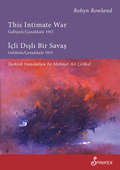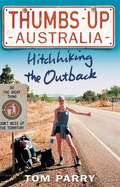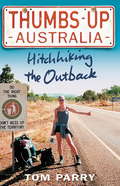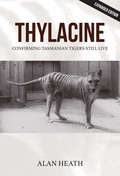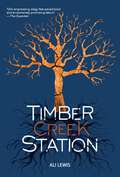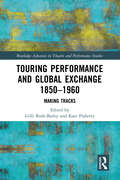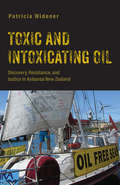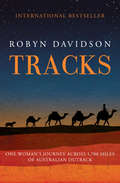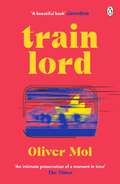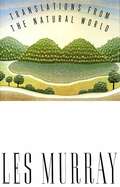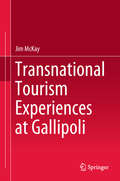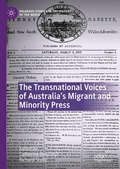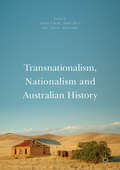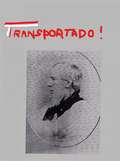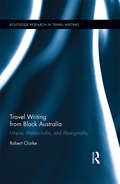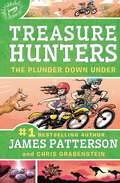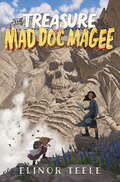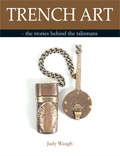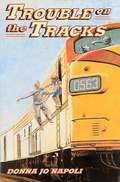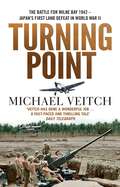- Table View
- List View
This Intimate War Gallipoli/Canakkale 1915: Icli Disli Bir Savas: Gelibolu/Canakkale 1915
by Mehmet Ali Celikel Robyn Rowland"Very few collections bring home so powerfully the vulnerability of individuals in the face of history," writes Lisa Gorton of Robyn Rowland's powerful poems recording the experiences of soldiers, nurses and doctors, women munitions workers, wives, mothers, composers, painters and poets during the Gallipolli War,1915. It began with the Battle of Çanakkale and the defeat of the British navy. The land battle was hand-to-hand killing, the physical closeness of its soldiers unmasking the depersonalization of the propaganda of war. Importantly, the book finishes with a poem on women's friendship 100 years after the war, and the healing nature of love.
Thumbs Up Australia: Hitchhiking the Outback
by Tom ParryOn the Road meets Down Under in this really rough guide to the adventures of an enthusiastic hitchhiker and his reluctant girlfriend on their quest for the real Australia. Hitching lifts with the desert's dodgiest drivers and taking breaks in the roughest roadhouses, this is Tom Parry's witty, warts-and-all tale of hitchhiking 8,000 miles across - and around - the Australian outback with his thumb, his backpack and his French girlfriend, Katia. As the couple hitch their way around the near empty highways, they encounter as wide a cross-section of Aussie society as you could ever hope to meet. In cattle stations, Aboriginal communities, remote waterholes, caravan parks, hippy communes and roadhouses, they see a country that remains as extraordinary today as it was for the first nineteenth century settlers. Loosely following the routes carved out by the legendary explorers who first traversed the great continent, the couple get to grips with the country's fascinating history. Set against a backdrop of the real Australia - not 'as seen on TV'- "Thumbs Up Australia" is full of wonderful anecdotes and endearing tales of some of the country's most idiosyncratic characters, from the grizzled Aboriginal elder with his tales of dreamtime, to an amphetamine-swallowing road train driver. And at the end of their journey, it is ironically Katia who suggests thumbing a lift to the airport!
Thumbs Up Australia: Hitchhiking the Outback
by Tom ParryOn the Road meets Down Under in this really rough guide to the adventures of an enthusiastic hitchhiker and his reluctant girlfriend on their quest for the real Australia. Hitching lifts with the desert's dodgiest drivers and taking breaks in the roughest roadhouses, this is Tom Parry's witty, warts-and-all tale of hitchhiking 8,000 miles across - and around - the Australian outback with his thumb, his backpack and his French girlfriend, Katia. As the couple hitch their way around the near empty highways, they encounter as wide a cross-section of Aussie society as you could ever hope to meet. In cattle stations, Aboriginal communities, remote waterholes, caravan parks, hippy communes and roadhouses, they see a country that remains as extraordinary today as it was for the first nineteenth century settlers. Loosely following the routes carved out by the legendary explorers who first traversed the great continent, the couple get to grips with the country's fascinating history. Set against a backdrop of the real Australia - not 'as seen on TV'- "Thumbs Up Australia" is full of wonderful anecdotes and endearing tales of some of the country's most idiosyncratic characters, from the grizzled Aboriginal elder with his tales of dreamtime, to an amphetamine-swallowing road train driver. And at the end of their journey, it is ironically Katia who suggests thumbing a lift to the airport!
Thumbs Up Australia
by Tom ParryWith anecdotes and endearing tales of characters met along the way, Thumbs Up Australia follows the exploits of an English hitchhiker and his reluctant French girlfriend as the two uncover a never-before-seen Australia. Tom Parry carries the reader through almost-empty highways and a distinctively Aussie society on a journey of 8,000 miles-with just as many adventures.
Thylacine
by Alan HeathThis book details how, in November 1993, during a holiday in northern Queensland, the author was first told by a witness to a Thylacine (Tasmanian Tiger), on Cape York Peninsula. It also details some of the many other Thylacine sightings on mainland Australia and in Tasmania that he has been told about up until 2014. The author wrote this book at the suggestion of an academic working at a Queensland university, after the author told the academic about some of the Thylacine sightings that he had been told about in Queensland.
Timber Creek Station
by Ali LewisDanny Dawson lives on a cattle station in the Australian outback. Usually the annual cattle muster excites Danny, but everything is different now. Because Danny's beloved older brother died in an accident last year, and nobody will talk about it. Because his teenage sister is pregnant and won't tell anyone who the father is. Because his mother can't cope with any of it and has hired a wide-eyed English house girl to deal with the family. Timber Creek Station is the story of a grieving family, entrenched racism, and the surprising ways one boy—who thought he'd be stuck in one terrible place forever—can take a leap forward.
To Salamaua
by Phillip BradleyFollowing on from his acclaimed book, The Battle for Wau, Phillip Bradley turns his attention to the Salamaua campaign - the first of the New Guinea offensives by the Australian Army in the Second World War. Opening with the pivotal air-sea battle of the Bismarck Sea, this important title recounts the fierce land campaign that was fought for the ridges that guarded the Japanese base at Salamaua. From Mount Tambu to Old Vickers and across the Francisco River, the Australians and their American allies fought a desperate struggle to keep the Imperial Japanese Army diverted from the strategic prize of Lae. To Salamaua covers the entire campaign in one volume for the first time. From the strategic background of the campaign and the heated conflicts, to the mud and blood of the front lines, this is the extraordinary story.
Touring Performance and Global Exchange 1850-1960: Making Tracks (Routledge Advances in Theatre & Performance Studies)
by Gilli Bush-BaileyThis collection uncovers connections and coincidences that challenge the old stories of pioneering performers who crossed the Atlantic and Pacific oceans from the mid-nineteenth to the mid-twentieth century. This book investigates songlines, drama, opera, music theatre, dance, and circus—removing traditional boundaries that separate studies of performance, and celebrating difference and transformation in style, intention, and delivery. Well known, or not known at all, travelling performers faced dangers at sea and hazardous journeys across land. Their tracks, made in pursuit of fortune and fame, intersected with those made by earlier storytellers in search for food. Making Tracks takes a fresh look at such tracks—the material remains—demonstrating that moving performance does far more than transfer repertoires and people; it transforms them. Touring performance has too often been conceived in diasporic terms, as a fixed product radiating out from a cultural centre. This collection maps different patterns—ones that comprise reversed flows, cross currents, and continually proliferating centres of meaning in complex networks of global exchange. This collection will be of great interest to scholars and students in theatre, music, drama studies and cultural history.
Toxic and Intoxicating Oil: Discovery, Resistance, and Justice in Aotearoa New Zealand (Nature, Society, and Culture)
by Patricia WidenerWhen oil and gas exploration was expanding across Aotearoa New Zealand, Patricia Widener was there interviewing affected residents and environmental and climate activists, and attending community meetings and anti-drilling rallies. Exploration was occurring on an unprecedented scale when oil disasters dwelled in recent memory, socioecological worries were high, campaigns for climate action were becoming global, and transitioning toward a low carbon society seemed possible. Yet unlike other communities who have experienced either an oil spill, or hydraulic fracturing, or offshore exploration, or climate fears, or disputes over unresolved Indigenous claims, New Zealanders were facing each one almost simultaneously. Collectively, these grievances created the foundation for an organized civil society to construct and then magnify a comprehensive critical oil narrative--in dialogue, practice, and aspiration. Community advocates and socioecological activists mobilized for their health and well-being, for their neighborhoods and beaches, for Planet Earth and Planet Ocean, and for terrestrial and aquatic species and ecosystems. They rallied against toxic, climate-altering pollution; the extraction of fossil fuels; a myriad of historic and contemporary inequities; and for local, just, and sustainable communities, ecologies, economies, and/or energy sources. In this allied ethnography, quotes are used extensively to convey the tenor of some of the country’s most passionate and committed people. By analyzing the intersections of a social movement and the political economy of oil, Widener reveals a nuanced story of oil resistance and promotion at a time when many anti-drilling activists believed themselves to be on the front lines of the industry’s inevitable decline.
Tracks: One Woman's Journey Across 1,700 Miles of Australian Outback (Vintage Departures Ser.)
by Robyn DavidsonThe incredible true story of one woman&’s solo adventure across the Australian outback, accompanied by her faithful dog and four unpredictable camels.I arrived in the Alice at five a.m. with a dog, six dollars and a small suitcase full of inappropriate clothes. . . . There are some moments in life that are like pivots around which your existence turns. For Robyn Davidson, one of these moments comes at age twenty-seven in Alice Springs, a dodgy town at the frontier of the vast Australian desert. Davidson is intent on walking the 1,700 miles of desolate landscape between Alice Springs and the Indian Ocean, a personal pilgrimage with her dog—and four camels. Tracks is the beautifully written, compelling true story of the author&’s journey and the love/hate relationships she develops along the way: with the Red Centre of Australia; with aboriginal culture; with a handsome photographer; and especially with her lovable and cranky camels, Bub, Dookie, Goliath, and Zeleika. Adapted into a critically acclaimed film starring Mia Wasikowska and Adam Driver, Tracks is an unforgettable story that proves that anything is possible. Perfect for fans of Cheryl Strayed&’s Wild.
Tracks
by Robyn DavidsonA cult classic with an ever-growing audience, Tracks is the brilliantly written and frequently hilarious account of a young woman's odyssey through the deserts of Australia, with no one but her dog and four camels as companions. Davidson emerges as a heroine who combines extraordinary courage with exquisite sensitivity.
Train Lord: The Astonishing True Story of One Man's Journey to Getting His Life Back On Track
by Oliver MolThe astonishing true story of trust, pain, becoming lost, and finding a way back to yourself despite it all'An intimate preservation of a moment in time, full of personality' THE TIMES__________Life is beautiful - even in the dark . . .Oliver Mol was happily drifting through his twenties when the migraine exploded in his head.Suddenly, he could barely function. He felt marooned. Nothing helped. Yet he was desperate to save himself.Then he found the trains. The job of train guard has intense moments of strict, regimented activity in between periods of calm serenity. It was just what Oliver needed. Not only could he do this, but also it might be a way out.Train Lord is the story of Oliver's extraordinary recovery. A journey back into the light . . .__________'Tender, vital and quietly hopeful: a tale of remaking' Guardian'Rude, raw, visceral, painful and wildly funny' Saga 'Intense and humble, Train Lord won my heart' Australian Book Review
Transit of Venus
by Julian EvansJulian Evans won a host of awards for this smart, funny, and thoughtful travelogue through the South Pacific islands. Evans was raised in Australia, but moved to England as a teenager, and forever longed to return to the Pacific of his childhood. He sails on a freighter from Australia to cross the Pacific, stopping at a series of ever more remote islands. Along the way he discusses the politics, history, and culture of the Pacific Islanders and the Europeans with whom they so uneasily co-exist. English, not American, spelling and punctuation; also dialect here and there
Translations from the Natural World
by Les MurrayThe centerpiece of this collection of poems is "Presence," a sequence of forty "translations from the natural world" about a variety of settings and their amazing denizens. Lyre birds, honeycombs, sea lions, possums, all act as spurs for Murray's protean talent for description and imitation.
Transnational Tourism Experiences at Gallipoli
by Jim McKayThis book offers a fresh account of the Anzac myth and the bittersweet emotional experience of Gallipoli tourists. Challenging the straightforward view of the Anzac obsession as a kind of nationalistic military Halloween, it shows how transnational developments in tourism and commemoration have created the conditions for a complex, dissonant emotional experience of sadness, humility, anger, pride and empathy among Anzac tourists. Drawing on the in-depth testimonies of travellers from Australia and New Zealand, McKay shines a new and more complex light on the history and cultural politics of the Anzac myth. As well as making a ground breaking, empirically-based intervention into the culture wars, this book offers new insights into the global memory boom and transnational developments in backpacker tourism, sports tourism and “dark” or “dissonant” tourism.
The Transnational Voices of Australia’s Migrant and Minority Press (Palgrave Studies in the History of the Media)
by Catherine Dewhirst Richard ScullyThis edited collection invites the reader to enter the diverse worlds of Australia’s migrant and minority communities through the latest research on the contemporary printed press, spanning the mid-nineteenth century to our current day. With a focus on the rare, radical and foreign-language print culture of multiple and frequently concurrent minority groups’ newspaper ventures, this volume has two overarching aims: firstly to demonstrate how the local experiences and narratives of such communities are always forged and negotiated within a context of globalising forces – the global within the local; and secondly to enrich an understanding of the complexity of Australian ‘voices’ through this medium not only as a means for appreciating how the cultural heritage of such communities were sustained, but also for exploring their contributions to the wider society.
Transnationalism, Nationalism and Australian History
by Anna Clark Anne Rees Alecia SimmondsUsing Australian history as a case study, this collection explores the ways national identities still resonate in historical scholarship and reexamines key moments in Australian history through a transnational lens, raising important questions about the unique context of Australia's national narrative. The book examines the tension between national and transnational perspectives, attempting to internationalize the often parochial nation-based narratives that characterize national history. Moving from the local and personal to the global, encompassing comparative and international research and drawing on the experiences of researchers working across nations and communities, this collection brings together diverging national and transnational approaches and asks several critical research questions: What is transnational history? How do new transnational readings of the past challenge conventional national narratives and approaches? What are implications of transnational and international approaches on Australian history? What possibilities do they bring to the discipline? What are their limitations? And finally, how do we understand the nation in this transnational moment?
Transportado
by Terry Rachelle Spring Combo Translations'TRANSPORTADO - A HISTÓRIA DO PIONEIRO' Com base na vida real de George Smith, a história conta como ele se voltou para o crime, teve sua sentença de morte comutada à vida nas colônias e surgiu de começos humildes para se tornar um proprietário de terras australiano pioneiro e rico. Chegando na colônia como uma juventude ingênua, ele aprende a lidar com gado e prosperar no campo severo e solitário, lidar com os nativos aborígenes em seu primeiro contato com pessoas brancas. Concedido a sua liberdade de ajuda na captura de um assassino assassino, ele começa a sonhar a terra impensável. Quando um fogo varre o campo, ele salva a cabeça tribal local e é concedido em troca, a mão da filha do chefe. Por acaso, George encontra uma maneira de ganhar dinheiro e a oportunidade de realizar seus sonhos e suas próprias terras. Sua esposa nativa morre pouco depois de entregar seu quinto filho e George viaja por terra para Sydney procurando uma governanta. Atraído por uma mulher irlandesa, ele propõe e aceita, retornando com ele para o distrito externo. Gradualmente, as crianças a aceitam como sua mãe e a família agora rica, começam a reivindicar a respeitabilidade.
Transportado
by Terry Rachelle Spring Combo Translations'TRANSPORTADO - A HISTÓRIA DO PIONEIRO' Com base na vida real de George Smith, a história conta como ele se voltou para o crime, teve sua sentença de morte comutada à vida nas colônias e surgiu de começos humildes para se tornar um proprietário de terras australiano pioneiro e rico. Chegando na colônia como uma juventude ingênua, ele aprende a lidar com gado e prosperar no campo severo e solitário, lidar com os nativos aborígenes em seu primeiro contato com pessoas brancas. Concedido a sua liberdade de ajuda na captura de um assassino assassino, ele começa a sonhar a terra impensável. Quando um fogo varre o campo, ele salva a cabeça tribal local e é concedido em troca, a mão da filha do chefe. Por acaso, George encontra uma maneira de ganhar dinheiro e a oportunidade de realizar seus sonhos e suas próprias terras. Sua esposa nativa morre pouco depois de entregar seu quinto filho e George viaja por terra para Sydney procurando uma governanta. Atraído por uma mulher irlandesa, ele propõe e aceita, retornando com ele para o distrito externo. Gradualmente, as crianças a aceitam como sua mãe e a família agora rica, começam a reivindicar a respeitabilidade.
Travel Writing from Black Australia: Utopia, Melancholia, and Aboriginality (Routledge Research in Travel Writing)
by Robert ClarkeOver the past thirty years the Australian travel experience has been 'Aboriginalized'. Aboriginality has been appropriated to furnish the Australian nation with a unique and identifiable tourist brand. This is deeply ironic given the realities of life for many Aboriginal people in Australian society. On the one hand, Aboriginality in the form of artworks, literature, performances, landscapes, sport, and famous individuals is celebrated for the way it blends exoticism, mysticism, multiculturalism, nationalism, and reconciliation. On the other hand, in the media, cinema, and travel writing, Aboriginality in the form of the lived experiences of Aboriginal people has been exploited in the service of moral panic, patronized in the name of white benevolence, or simply ignored. For many travel writers, this irony - the clash between different regimes of valuing Aboriginality - is one of the great challenges to travelling in Australia. Travel Writing from Black Australia examines the ambivalence of contemporary travelers' engagements with Aboriginality. Concentrating on a period marked by the rise of discourses on Aboriginality championing indigenous empowerment, self-determination, and reconciliation, the author analyses how travel to Black Australia has become, for many travelers, a means of discovering 'new'--and potentially transformative--styles of interracial engagement.
Treasure Hunters: The Plunder Down Under (Treasure Hunters #7)
by James Patterson Chris GrabensteinWith their parents in trouble once again, the Kidds must traverse the Australian Outback, recover a pair of stolen gems, and defeat treasure-hunting pirates to save them!The Kidd family is on their way to Australia to find Lasseter's Gold when they are challenged by fellow treasure hunter Charlotte Badger, who challenges them to a race to the gold! But when the Kidds pull into port in Australia, their parents are suddenly arrested -- they've been framed! It turns out Charlotte Badger is a pirate, and she's planted a priceless stolen black opal on the Kidds' ship, The Lost!Now Bick, Beck, Storm, and Tommy have seven days to traverse the Australian Outback, find Charlotte Badger and her pirate cronies, and bring back the evidence that will prove their parents innocent. If they fail, their parents will be found guilty and thrown in prison . . . forever!
The Treasure of Mad Doc Magee
by Elinor TeeleA rip-roaring puzzle box of an adventure about grit, guts, and gold, from Elinor Teele, the acclaimed author of The Mechanical Mind of John Coggin.The small, run-down town of Eden is the only place Jenny Burns has ever called home. The roots of the trees are in her bones, the air of the mountains is in her breath, the lakes and rivers are in her blood. And that’s why, when her father loses his job and tells Jenny that they may have to move on from Eden, she knows she can’t let that happen.The fever of New Zealand’s gold rush still runs in the veins of Eden, and everyone knows the legend of Doc Magee: how he found the largest gold nugget anyone had ever seen and hid it somewhere in the hills before he disappeared.Jenny and her best friend, Pandora, know that if they can find the gold, it’ll solve all their problems. But the way is fraught with mysteries, riddles, and danger—and those are just the threats they know about. Before her quest is over, Jenny will have to face challenges from within as well as from without.
Trench Art: the stories behind the talismans
by Judy WaughThis unique collection of trench art evokes emotion. Each piece was created in turmoil but all are beautiful - intuitive works of art about music, faith, love and honour. 56 pieces are from WWI. All are signed with name and service number. Most are small and tactile, often worn as a fob. Many are made from coins and brass from the battlefield; some are carved in bone and wood. Most belonged to young soldiers who were killed in action or died of their wounds - at Gallipoli, France and Flanders, Palestine and Mesopotamia. Twelve belonged to Anzacs. This book tells their stories - of men from England, Scotland, Wales, Australia and New Zealand, bound by adventure and loyalty to their common ancestry. . . . . . The engraved ID holds the key to the story. The heart of each story is different. There are stories of courage under fire and desertions at Colombo; of death from sunstroke and survival through three theatres of war; of medals awarded and fines for misadventures; of men from the Outback in Queensland and young lads from Boys Homes in Kent. There are insights into social history - the ostracism and disgrace of venereal disease, the generational poverty in industrial cities, the imperative to secure oil lines in Iraq. And there are heartbroken letters from those left behind. . . . . . This book will appeal to collectors of artefacts, coins and militaria. It will also appeal to those interested in family history, social history, military history and art therapy in trauma. So much can be found from so little. The range of artefacts may also interest researchers. There are over 64 artefacts in all, including two from the Boer War, one from Crimea, and seven from the convict era - all bearing testament to the primal need to carve a name.
Trouble on the Tracks
by Donna Jo NapoliWhile traveling across the Australian outback on a train, thirteen-year-old Zach and his younger sister, Eve, uncover an endangered bird-smuggling ring and try to save two trains from a full-speed collision.
Turning Point: The Battle for Milne Bay 1942 - Japan's first land defeat in World War II
by Michael VeitchSeptember 1942 marked the high-point of Axis conquest in World War II. In the Pacific, Japan's soldiers had seemed unstoppable. However, the tide was about to turn.On Sunday, 6 September 1942, Japanese land forces suffered their first conclusive defeat at the hands of the Allies. At Milne Bay in Papua New Guinea, a predominantly Australian force - including 75 Squadron (fresh from their action in 44 Days) - fought for two weeks to successfully defend a vital airstrip against a determined Japanese invasion. The victorious Australian army units were crucially supported by two locally-based squadrons of RAAF Kittyhawks.The Battle for Milne Bay and victory for the Allies was a significant turning point in the Pacific War, but while it received worldwide publicity at the time, it has since been largely forgotten... It deserves to be remembered. Michael Veitch, actor, presenter and critically acclaimed author, brings to life the incredible exploits and tragic sacrifices of these Australian heroes in another fast-paced and thrilling tale.
